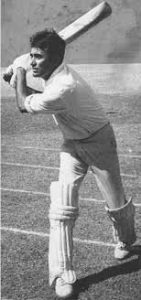 Prof Satya Narayan Misra in Bhubaneswar, April 4, 2023: On the eve of the last day of the Port of Spain test against the mighty West Indies. Salim Durani promised Ajit Wadekar, the captain that he will take the wicket of Garfield Sobers, the greatest all-rounder of all time and captain of the Windies team. He not only befuddled and bowled Sobers for a duck with a googly he also scalped the loping leopard, Clive Loyd, leaving India to score 125 to win.
Prof Satya Narayan Misra in Bhubaneswar, April 4, 2023: On the eve of the last day of the Port of Spain test against the mighty West Indies. Salim Durani promised Ajit Wadekar, the captain that he will take the wicket of Garfield Sobers, the greatest all-rounder of all time and captain of the Windies team. He not only befuddled and bowled Sobers for a duck with a googly he also scalped the loping leopard, Clive Loyd, leaving India to score 125 to win.
This first overseas win against West Indies saw Dillip Sardesai scoring a brilliant century and rise of an all-time great Indian star cricketer Sunil Gavaskar , who scored an unbeaten 67 in the second innings. He was also the hero of India’s victory against England at Calcutta and Madras in 1961-62 taking eight and ten wickets respectively. His magical spinning figures lured batsmen to their doom.
He played test cricket from 1960-73 and scored a solitary century (112) against the West Indies. But he will not be remembered for the number of runs he scored or the number of wickets he took, but the manner in which he regaled the crowd or made an impact on India’s victory.
He was the first debonair and glamorous cricketer, who along with Tiger Pataudi, ML Jaishima (poor man’s Sobers) and Abbas Ali Baig , who was kissed by a damsel on the field , was called the Marlboro Man of India , much before Farokh Engineer was called the Bryl cream Man. He was synonymous with his swag and chutzpah, on and off the field, much before Viv Richards made swagger his signature tune of arrival at the wicket to intimidate the bowlers.
He was famous for the sixes he could hit at will; more so when the crowd demanded. He had four to five shots for every ball and could loft the ball over extra cover with supreme ease, much like Yuvaraj Singh in later years. But the shot that marked him out as a batsman was the crisp late cut going back foot. It has a magical quality about it, which I was privileged to watch in a match against Bombay when he delicately late cut Padmakar Shivalkar thrice to the boundary. In an age of orthodox batting, he was the pied piper of innovation, much like Rohan Kanhai would play the falling sweep, completely confounding the purists.
 He was also the stormy petrel of Indian cricket, carrying the irreverent attitude & legacy of Lala Amarnath. Pataudi did not like his lack of discipline. When the selectors threatened to drop him from the test at Brabourne stadium at Mumbai in 1972, the crowd protested and he was included. He responded by scoring a blistering 73. But he was not lucky in the Kanpur Test in 1973, when he was dropped.
He was also the stormy petrel of Indian cricket, carrying the irreverent attitude & legacy of Lala Amarnath. Pataudi did not like his lack of discipline. When the selectors threatened to drop him from the test at Brabourne stadium at Mumbai in 1972, the crowd protested and he was included. He responded by scoring a blistering 73. But he was not lucky in the Kanpur Test in 1973, when he was dropped.
The crowd went up with placards ‘No Durarani No Test’. Much the same way when Kapil Dev was dropped by Gavaskar in the 1984 test match against England at Calcutta’s Eden’s Garden, when the crowd billowed “No Kapil No Test’. He had the charisma of Kapil and defiance of Keith Miller with Bradman or Shane Warne with Steve Waugh.
He was a multi-faceted character who cavorted with music directors like Hemant Mukherjee or directors like Shakti Samanta. BR Ishara roped him as a hero opposite the controversial movie Charitra opposite the sexy siren of those times, Praveen Babi. He had close interaction with the maestro Satyajit Ray.
He had that indefinable charm that endeared him to the cultural world. In an age where television was passes and orthodoxy was the norm he was like a whiff of fresh air, who brought joy to the crowd, character to cricket and freed batting and bowling from dour rigour and restraint.
As the IPL ushers in enormous unorthodoxy in terms of batting like reverse sweep, flick over wicket keepers head, Durani’s lofted drive over extra cover or his late cuts would always be remembered with nostalgia. He was the original T 20 man who had the character to play luminescent classical test cricket. delight both the hoi polio or the cognoscenti.
There is a swirling debate that he was of Afghan origin. One discovers the war in the open skies on the Khyber Pass where his mother was travelling. No wonder, Durani remains a romantic, a bohemian, of rare timber in cricket.
Prof Misra is a cricket aficianado


Leave a Reply
Be the First to Comment!